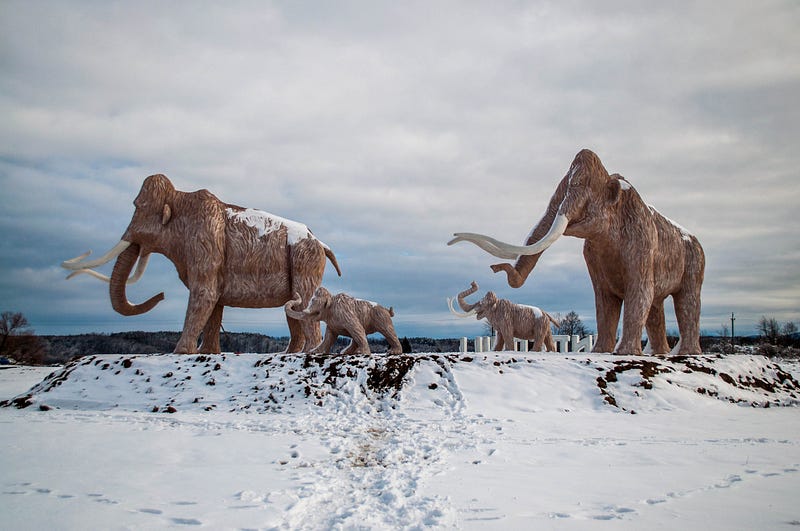Reviving the Woolly Mammoth: Can CRISPR Make It Possible?
Written on
The Concept of De-Extinction
Could advancements in genetic engineering and reproductive technology allow for the revival of the Woolly Mammoth? The idea may sound like something out of a science fiction movie, reminiscent of Jurassic Park, where geneticists create living dinosaurs for a theme park. However, the feasibility of such a process in real life is being explored, particularly using CRISPR technology.
Creating life from the past, as depicted in Jurassic Park, poses numerous challenges.
Understanding CRISPR
CRISPR is a groundbreaking gene-editing tool often described as “word processing for DNA.” This technology enables scientists to make precise cuts and modifications within genomes with relative ease and cost-effectiveness. Its significance was recognized with the 2020 Nobel Prize in Chemistry awarded to Jennifer Doudna and Emmanuelle Charpentier, who are pioneers in the field. For those interested in the intricacies of CRISPR, there are detailed resources available that delve into its history and functionality.
Reviving the Woolly Mammoth
So, how could scientists potentially bring back the Woolly Mammoth? The process is not too dissimilar from the fictional methods shown in Jurassic Park. In the movie, DNA from dinosaurs was extracted from fossils preserved in amber, and incomplete genomes were completed using DNA from modern-day frogs. With a complete genome, the scientists implanted it into ostrich eggs to create living dinosaurs.
In reality, a company named Colossal is leading an initiative to resurrect the Woolly Mammoth. The scientists began with a fully sequenced genome from excavated specimens and compared it to the genome of the Asian Elephant, its closest living relative. Although the two species share around 99.6% of their genetic material, there are still significant differences—1.4 million letters apart. The researchers chose to focus on 50 specific traits that would help replicate the Woolly Mammoth’s unique adaptations, such as its smaller ears and thicker fat layer for cold climates.
Colossal's strategy involves starting with the genome of an Asian Elephant and using CRISPR to edit specific segments to resemble that of a Woolly Mammoth. The next step would be to transfer this hybrid DNA into an Asian Elephant egg cell and stimulate fertilization through electrical pulses. Ultimately, the goal is to nurture the embryo in an artificial womb, a method previously tested on lambs. However, creating a suitable environment for a 2,000-pound animal over its lengthy gestation period remains a challenge.

Environmental Benefits of Reviving the Mammoth
Why should we even consider reviving the Woolly Mammoth? Firstly, it would signify a remarkable achievement in scientific innovation. Additionally, the Woolly Mammoth could play a crucial role in combating climate change.
Approximately 20,000 years ago, these magnificent creatures thrived in the frigid grasslands of Siberia. They significantly influenced their ecosystems by promoting the growth of grasslands, which in turn reflected sunlight and cooled the ground. Their grazing habits and snow-trampling behavior helped preserve permafrost, a crucial carbon sink that, if thawed, releases greenhouse gases into the atmosphere, exacerbating climate change.
As the Arctic continues to warm and permafrost melts, the hope is to release thousands of revived Woolly Mammoths into Siberia to restore the grasslands and protect the permafrost once more.
Scientific Implications and Future Prospects
Beyond environmental restoration, reviving the Woolly Mammoth could enhance our understanding of artificial womb technology, potentially aiding in the development of solutions for premature births in humans. The knowledge gained could also lead to advancements in genetic modifications across various species, with significant implications for agriculture.
The first video titled Could The Woolly Mammoth Be Brought Back? explores the possibility of reviving this extinct species through genetic technologies and discusses the implications of such a feat.
The second video, How to Clone a Mammoth: The Science of De-Extinction, features Beth Shapiro discussing the scientific processes and challenges involved in bringing back the Woolly Mammoth.
Conclusion
What are your thoughts on the potential to resurrect the Woolly Mammoth? Please share your insights in the comments below—I'll do my best to respond to all thoughtful contributions!
Interested in more? Check out these articles:
- A “De-Extinction” Company Plans to Revive the Already Extinct Tasmanian Tiger
- The History and Science Behind CRISPR Gene-Editing
- CRISPR Gene Editing Could be Coming to a Supermarket Near You
References
- Okoyomon, Adesuwa. “Science of Jurassic Park: Can an Extinct Animal Be Recreated from a DNA-Filled Mosquito?” Science World, 7 July 2022.
- “The Nobel Prize in Chemistry 2020.” NobelPrize.org.
- “May Prehistory Thunder Forward: The Resurrection of the Woolly Mammoth.” Colossal.
- Magazine, Smithsonian. “These Scientists Plan to Fully Resurrect a Woolly Mammoth within the Decade.” Smithsonian Institution, 14 Sept. 2021.
- DNewsChannel, director. YouTube, 20 Oct. 2021.
- “What Is Permafrost?” NASA.
- Partridge, Emily A., et al. “An Extra-Uterine System to Physiologically Support the Extreme Premature Lamb.” Nature Communications, vol. 8, no. 1, 2017.
- Doudna, Jennifer A., and Samuel H. Sternberg. A Crack in Creation: Gene Editing and the Unthinkable Power To Control Evolution. Houghton Mifflin Harcourt, 2018.